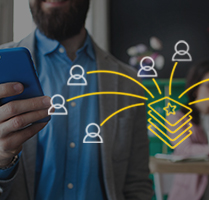7 Steps to Create a Successful Employee Recognition Program

Employee recognition programs are the backbone of a positive company culture where workers feel valued and appreciated. Launching one has no downsides, but it does take some effort and creativity on the employer’s part.
The most important thing to remember is employees are a company’s most valuable asset. Their satisfaction and motivation directly affect business outcomes. Formalizing a recognition and rewards system boosts performance, employee retention, and employer brand.
Jump in to learn how to build, launch, and refine a recognition initiative that delivers powerful results.
1. Assess current practices
The first step to revamping an employee recognition program is to audit current practices. Even without a formal system in place, it’s essential to see how recognition culture currently operates.
Speak to a group of employees with varying levels of tenure and hierarchy. Diversify across departments and locations to understand how consistent accolades and rewards are delivered.
2. Define program goals
After establishing what is and isn’t working, it’s time to formalize the program objectives. A strong recognition program uses the organization’s values as a base. Company culture, employer brand strategies, and overarching business drivers heavily influence these goals.
Consider what this initiative needs to accomplish and deploy the SMART criteria to ensure goals are specific, measurable, achievable, relevant, and time-oriented. A few examples could include:
- Increase employee retention by 10 percent within six months
- Reach 80 percent uptake within one year of program launch
- Boost employee referrals by 20 percent within three months
To make goals measurable, you’ll need a baseline for employee satisfaction, turnover, retention, and engagement metrics. Work with HR, internal communications, and IT teams to understand the current data points.
3. Identify employee preferences
Understanding what motivates employees is critical to keeping them feeling appreciated and content.
Use surveys to glean employee feedback on preferences for praise, the types of rewards they’re interested in, and how they feel about the current company culture. Some companies resort to culture meetings or focus groups to better understand the sentiment surrounding rewards programs.
Refer to reputable studies like Deloitte’s Total Rewards and Workforce Experience report. It highlights how public praise from senior leadership, direct supervisors, and colleagues is a form of recognition employees prefer the most.
4. Draft a recognition program
Annual, performance-based recognitions and rewards are routine and occur behind closed doors or in private meetings. Since employees thrive on public and frequent praise, public recognition is crucial to success.
Reaching major milestones and overcoming obstacles are excellent activities to recognize. Workers also appreciate all kinds of positive feedback, including celebrating life events, small wins, and daily notes of gratitude.
Peer-to-peer recognition is an important way to encourage public acknowledgment of a job well done and contributes to a supportive team mentality. The ideal program makes praise and rewards easy to share, ties efforts to company values, and connects different teams.
5. Identify the rewards or incentives for the program
Employees feel more satisfied when they believe their employer cares about their interests and well-being. Yet, generic rewards or one-size-fits-all approaches for unpopular prizes fail to convey this concern.
Personalizing rewards makes the experience more valuable to workers. For instance, offering workers a choice of gift cards for over 2000 stores or choosing from a selection of brands that speak to the interests of team members.
Offering choice demonstrates the company’s commitment to worker satisfaction. As workplace diversity increases, rewards must be more personalizable to appeal to most employees.
6. Choose the right tools and platforms
Employee recognition platforms foster participation through gamification and social recognition, all while ensuring accessibility across organizations.
Ensure the platform supports scalability, user-friendliness, and customization. Prioritize options that integrate with HR and communication software and allow API connections with bulk gift card providers. This approach reduces the cost of rewards and makes distribution more efficient.
Investing in recognition platforms lets employees know the program is a priority.
7. Announce and launch the program
Effective communication and employee buy-in lead to strong program adoption.
Create a communication strategy explaining the system’s details, benefits, and participation methods. Utilize multiple channels to reach employees where they are most receptive.
Choose an executive or team of leaders to support the program publicly and encourage participation. Once launched, these higher-ups must be visibly active and motivational on the platform.
Follow up with additional reminders after the initial launch. Encourage participation by sharing success stories, holding training sessions, and incentivizing early adopters.
Tips for successful recognition programs
Employee recognition programs are ongoing initiatives. They need refinement as time goes on. Use these additional tips to keep things impactful:
Solicit feedback after the first few weeks. Identify areas that need more clarification, training, or customization.
Use gamification to keep employees involved. Point systems, engagement badges, and leaderboards encourage healthy competition.
Train managers on how to effectively acknowledge employees. Consistent recognition impacts worker satisfaction and motivates others to heap praise on the praise.
Track participation and recognition frequency rates. Check-in on the progress of the original objectives and adjust accordingly.
Include the program in the employee recruitment and onboarding processes. If it’s a priority, it should be one of the first things new employees learn about the company.
Conclusion: Personalize employee achievement with a brand they love
A well-designed recognition program includes public and frequent praise tied to the company’s core principles. Clear and measurable objectives aligned with company values influence engagement and impact. The opportunity for peers to recognize each other is a key component.
Effective communication and leadership support ensure strong program adoption. Choosing the right platform and prizes is fundamental to success. Corresponding tools must be scalable, user-friendly, and efficient.
It’s wise to connect with workers frequently to understand their reward preferences. This approach keeps employees motivated and demonstrates the importance of workers’ interests and well-being to the company.
Explore how bulk gift cards offer the personal touch to reward-based recognition programs employees appreciate the most.
Request a demo to learn how much you’ll save by integrating bulk gift cards from NeoCurrency into your employee recognition program.
Recommended articles (helpful links)
- Employee Recognition: How Employees Want To Be Rewarded
- The Power of Choosing the Right Gift Card API Provider
- Unlocking Success: Elevating Mobile Phone Upgrades




